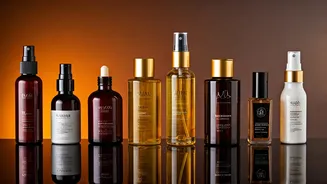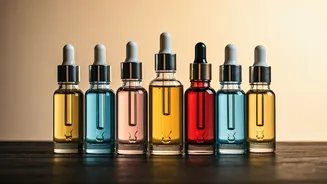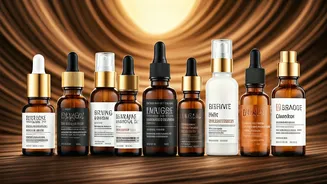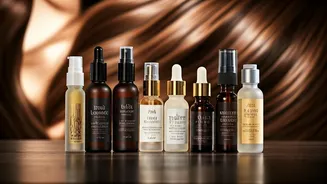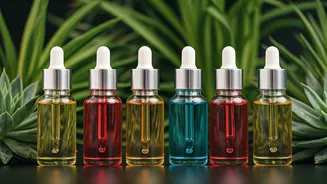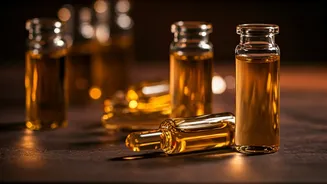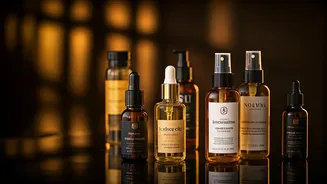Serum Selection Criteria
Selecting the right hair growth serum involves understanding what makes a product effective. The primary considerations include the ingredients, the serum's
formulation, and the clinical evidence supporting its claims. Ingredients like minoxidil are often clinically proven to promote hair growth. Additionally, the serum's consistency and ease of application play a key role in regular use. The serums should also be free of harsh chemicals that could irritate the scalp, prioritizing safe and effective options. Furthermore, we must consider user reviews, which offer real-world insights into a product's performance and long-term results. We assess how well each serum fits various hair types and addresses different hair concerns. The goal is to provide a curated selection of serums that are both powerful and safe, helping users make informed decisions for better hair growth outcomes.
Minoxidil's Role Explained
Minoxidil is one of the most well-studied ingredients in hair growth serums, often recommended for addressing hair loss. It functions by widening blood vessels in the scalp, enhancing blood flow to hair follicles, which stimulates growth. This increased blood supply provides follicles with more oxygen and nutrients, making the growth process more robust. Minoxidil has been proven effective in several clinical trials and is particularly useful for those experiencing androgenetic alopecia, commonly known as male-pattern or female-pattern baldness. Using minoxidil usually shows results within a few months of regular use, as it slowly reawakens dormant follicles. While minoxidil is available over-the-counter and is generally safe, users must adhere to application instructions and understand that results vary depending on individual factors, like genetics and the nature of hair loss.
Peptides: Growth Boosters
Peptides are short chains of amino acids that serve as building blocks for proteins, playing an important role in hair health. Peptides in hair growth serums stimulate the scalp and strengthen hair follicles, leading to improved hair growth. They can influence the hair growth cycle, encouraging the follicles to stay in the growth phase, leading to fuller hair. These growth-stimulating peptides also help the hair shaft and scalp by creating a healthier environment. When used in serums, peptides provide vital nutrients that lead to stronger, more resilient hair that's less prone to breakage. This often leads to noticeable improvements in hair density and overall hair appearance. The integration of peptide-rich serums into a regular hair care routine is an effective method for enhancing hair health.
Finasteride: Addressing Hair Loss
Finasteride is a powerful ingredient often included in hair growth serums to combat hair loss. It acts by blocking the production of dihydrotestosterone (DHT), a hormone that shrinks hair follicles, leading to hair loss in both men and women. By reducing DHT levels, finasteride prevents further follicle damage, which supports hair regrowth. Finasteride is usually available with a prescription and requires continuous use to maintain its effectiveness, often showing its best results after several months of use. While effective, finasteride may have potential side effects, which include altered hormone levels and should be used under the guidance of a healthcare professional. Careful monitoring and open communication with your doctor will guarantee the safe use of finasteride-based serums.
Natural Ingredients to Consider
Many hair growth serums are infused with natural ingredients that support hair health and growth. Essential oils such as rosemary and peppermint are believed to boost circulation and stimulate the scalp, leading to better hair growth. Rosemary oil, in particular, has gained popularity for its potential to hinder DHT, while peppermint provides a refreshing boost. Other important additions include plant extracts such as saw palmetto, which is traditionally known for its ability to regulate hormones that affect hair loss. Caffeine is another key ingredient, known to energize the scalp and promote growth. Integrating these natural ingredients into your hair care routine is a holistic approach to hair growth and overall scalp health.
Application and Routine Tips
For the best results, the application of hair growth serums should be consistent, typically once or twice daily, according to the product instructions. The best approach starts with a clean scalp, allowing the serum to reach the follicles effectively. Apply the serum directly to the scalp, using the dropper or applicator to target areas of concern or overall thinning. Then gently massage the serum into the scalp to boost circulation and enhance absorption. Many serums work best when left on, so avoid rinsing your hair right after application. Incorporating a hair growth serum into a complete hair care routine involves proper cleansing, conditioning, and nutrition. A balanced diet and regular scalp massage can complement the serum's effects, ensuring your hair follicles receive the best possible support for growth.
Expected Results and Maintenance
The time it takes to see results from hair growth serums varies depending on the specific product, the user, and the severity of hair loss. Generally, most users will see a noticeable improvement in hair growth after a few months, with the most significant changes visible after about six months of consistent use. You will often notice a reduction in hair shedding and an increase in new hair growth. Continuous use is usually needed to maintain results; once discontinued, the hair growth may reverse. Consider combining a serum with lifestyle changes, such as stress management, a balanced diet, and avoiding harsh treatments to boost results. Remember, patience and consistency are key to achieving and keeping your hair growth goals.





